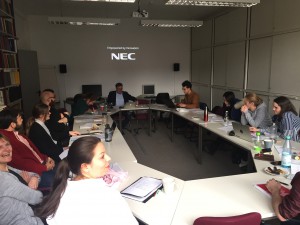In a workshop on “phenomenological videography”, which took place on the 9th of March 2017 at HU Berlin, Department of General Education and Philosophy of Education, we explored the practice and theory of pedagogical attentiveness. We discussed different theories of attentiveness (mindfulness, awareness, ethics of attentiveness) and made them fruitful for pedagogical contexts. Starting from a theory of inter-attentionality, which we developed in our videographical research Berlin, aspects of phenomenological and videographical methodology were presented and discussed (Pedagogical-Phenomenological Videography, Embodiment and Learning).
From an etymological perspective, the German word for attentiveness (Achtsamkeit) is related to the verb “to esteem” (achten) and the nouns “respect” and “attention” (Schätzen, Beachtung, Aufmerksamkeit). There are three different levels of meaning: a) “to deem sth as …” (dafürhalten, erachten); b) “to consider sth” (beachten); c) “to pay attention to sth” (acht geben). As a contrary meaning to these terms, we also find the word “despise” (verachten). Being attentive thus means to be careful and to consider something with full attentiveness (http://woerterbuchnetz.de/DWB/?sigle=DWB&mode=Vernetzung&lemid=GA01898#XGA01898).
Attentiveness is an abstract concept, not a phenomenon. It can become a phenomenon, however, if we transfer it into a concrete form of practice. Then we can differentiate various practices of attentiveness: looking closely at sth, listening to sth, turning to sth or someone, encouraging someone and – in the horizon of negativity – to keep someone from doing sth and to restrict someone.
Attentiveness is an ambivalent, embodied practice of being open towards the world in the mode of “releasement” or “calm composure” (Gelassenheit, Heidegger). From a pedagogical perspective it is a normative practice, which is directed towards the Other. These practices of attentiveness can be described in a qualitative way and can be captured videographically, as they are related to embodied interactions (Verkörperungen) – at least this was our thesis.
In the following data session, we analysed video data from our research project research project and tried to relate the outcomes of the analysis to a theory and practice of pedagogical attentiveness.



Malte Brinkmann (Photography: Martin Pohl and Johannes Türstig)


Leave a Reply
You must be logged in to post a comment.